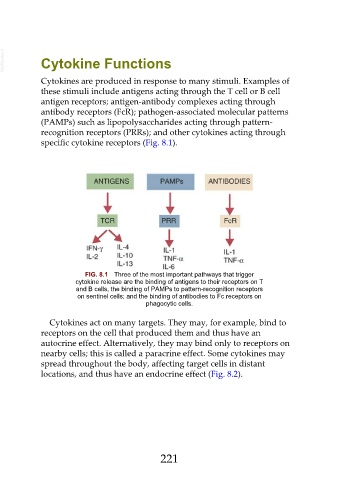Page 221 - Veterinary Immunology, 10th Edition
P. 221
VetBooks.ir Cytokine Functions
Cytokines are produced in response to many stimuli. Examples of
these stimuli include antigens acting through the T cell or B cell
antigen receptors; antigen-antibody complexes acting through
antibody receptors (FcR); pathogen-associated molecular patterns
(PAMPs) such as lipopolysaccharides acting through pattern-
recognition receptors (PRRs); and other cytokines acting through
specific cytokine receptors (Fig. 8.1).
FIG. 8.1 Three of the most important pathways that trigger
cytokine release are the binding of antigens to their receptors on T
and B cells, the binding of PAMPs to pattern-recognition receptors
on sentinel cells; and the binding of antibodies to Fc receptors on
phagocytic cells.
Cytokines act on many targets. They may, for example, bind to
receptors on the cell that produced them and thus have an
autocrine effect. Alternatively, they may bind only to receptors on
nearby cells; this is called a paracrine effect. Some cytokines may
spread throughout the body, affecting target cells in distant
locations, and thus have an endocrine effect (Fig. 8.2).
221

